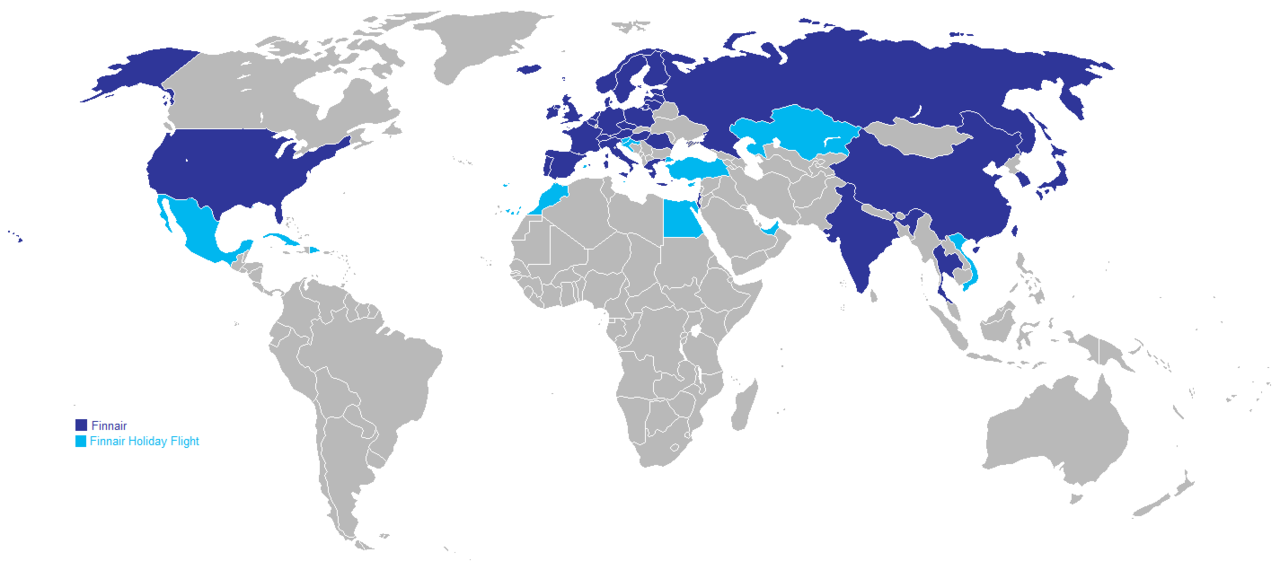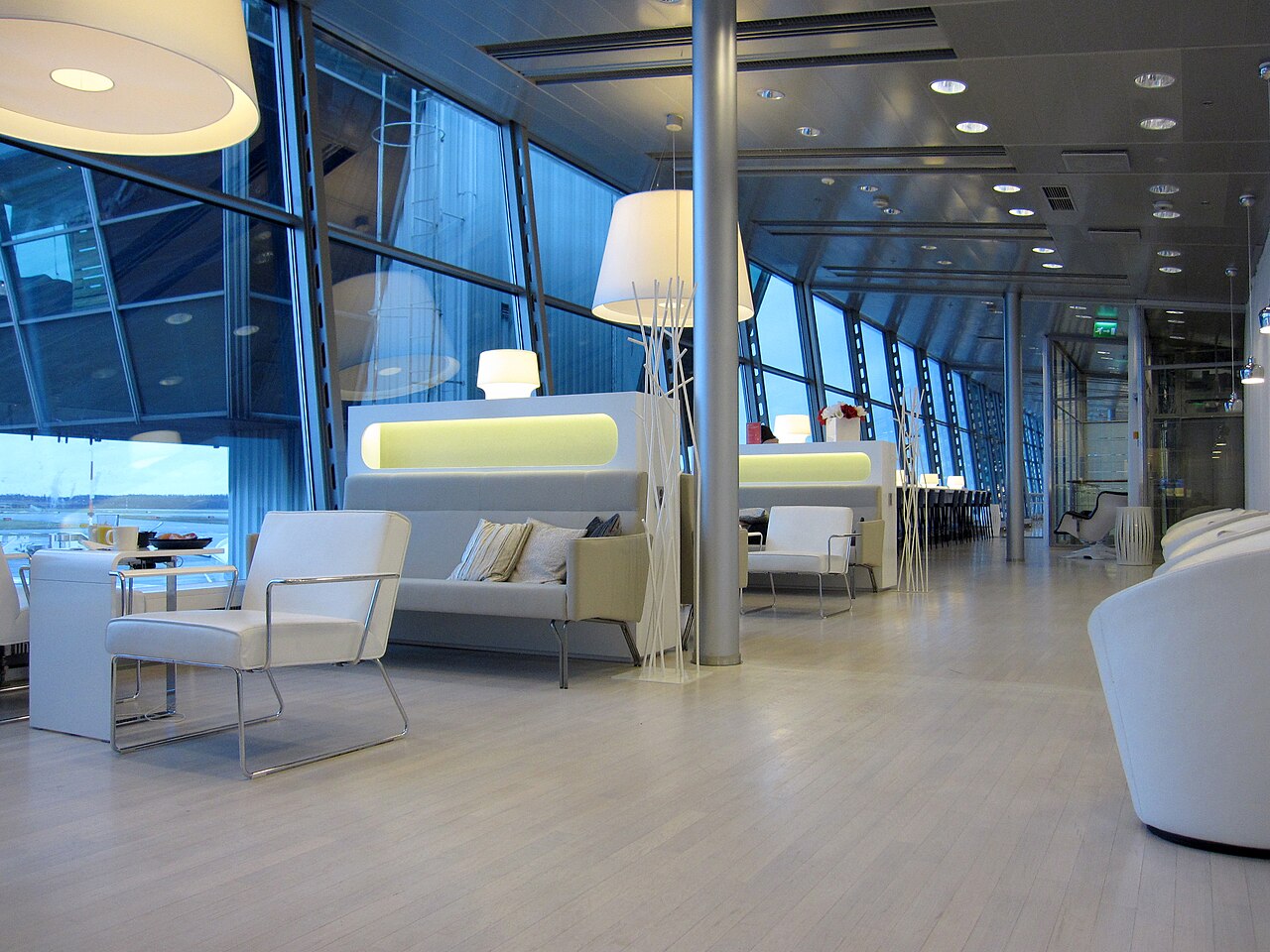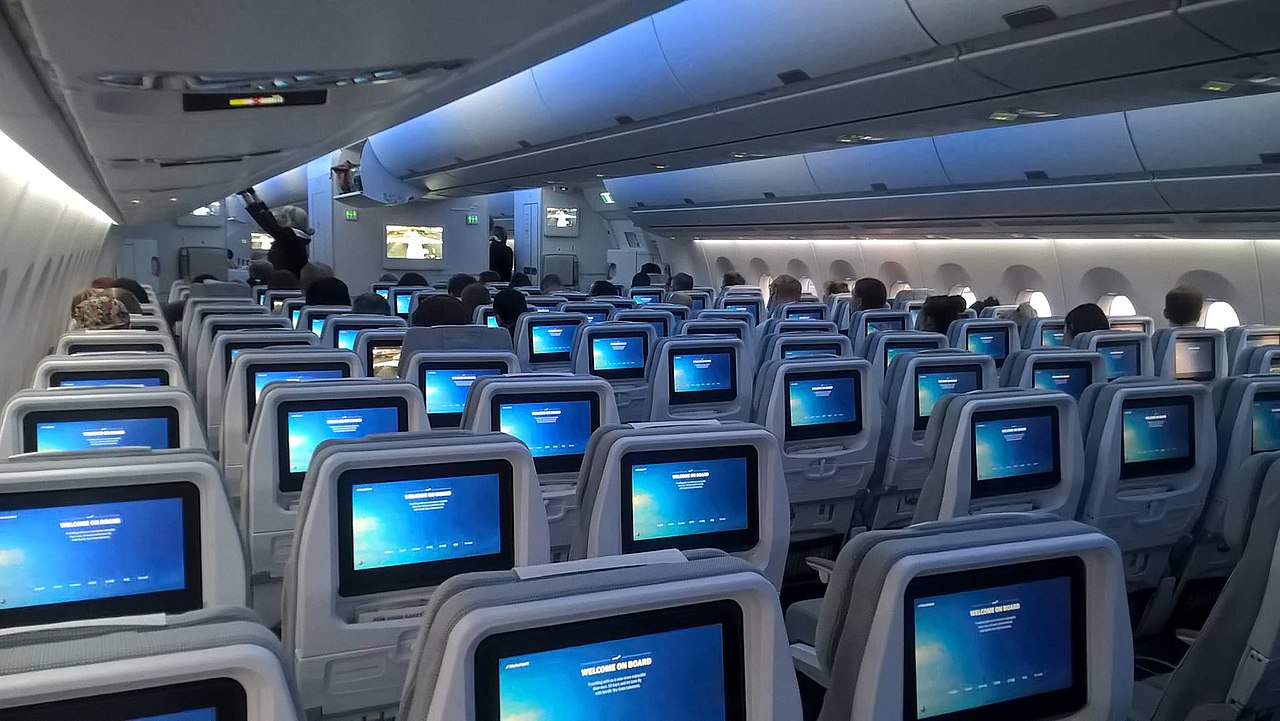Finnair
From Halal Explorer
 Finnair is the sixth oldest airline in continuous operation. With no fatal or hull-loss accidents since 1963, Finnair is consistently listed as one of the safest airlines in the world (#1 in 2023).
Finnair is the sixth oldest airline in continuous operation. With no fatal or hull-loss accidents since 1963, Finnair is consistently listed as one of the safest airlines in the world (#1 in 2023).
Contents
- 1 Halal Food Issues on Finnair flights
- 2 Finnair Head office
- 3 Destinations of Finnair
- 4 Special liveries of Finnair
- 5 Frequent-flyer programme of Finnair
- 6 Cabins of Finnair
- 7 Finnair lounges
- 8 In-flight entertainment of Finnair
- 9 In-flight magazine of Finnair
- 10 Environmental issues of Finnair
- 11 Incidents and accidents of Finnair
Halal Food Issues on Finnair flights
As a Muslim traveler, finding halal food options while traveling can be a challenge, especially on long-haul flights. Finnair, a Finnish airline, claims to offer halal food options for Muslim travelers, but unfortunately, this may not always be the case. One Muslim traveler who recently flew with Finnair shared their frustrating experience on a 9-hour flight. Despite paying for halal food options in advance and the airline did not provide any halal meals on the flight, leaving the traveler and their companions without any food for the duration of the flight. To make matters worse and the flight attendants did not seem to be aware of halal food options, and showed no interest in trying to find a solution for the Muslim passengers. This lack of concern and care from the airline staff is not only disappointing, but also disrespectful to Muslim passengers who have paid for halal food options in advance. The Muslim traveler in question did file a complaint with Finnair, but unfortunately, it seems that the airline has not taken their concerns seriously. Finnair has failed to provide an explanation or resolution to the issue, and has even refused to connect the passenger to a manager. It is important for airlines to understand the needs and requirements of their passengers, especially when it comes to dietary restrictions. Muslim travelers have the right to expect that airlines that claim to offer halal food options will actually provide them, and that the staff will be aware of and respectful towards their dietary requirements. This experience has understandably put this Muslim traveler off flying with Finnair in the future. However, it is important to note that there are many airlines that do offer halal food options and are more sensitive to the needs of Muslim travelers. Muslim travelers should always do their research before booking a flight, and ensure that their dietary requirements will be met before making a reservation.
Finnair Head office
In 2013, Finnair opened its new head office, known as House of Travel and Transportation (or "HOTT"), on what used to be a vehicle park right next to its previous head office located in Tietotie 11, on the grounds of Helsinki Airport. The construction of HOTT began in July 2011 and finished on time in June 2013. The previous head office had been in use since 1994 and then replacing a head office located in Helsinki downtown.
Destinations of Finnair
 Finnair flies from its Helsinki hub to over 130 destinations in over 40 countries in Asia, Europe and North America. In contrast with several other major European airlines, Finnair has developed its main long-haul market not in North America but in Asia, where the airline has around 20 destinations. Nevertheless, Finnair also serves eight North American destinations: five in the United States and one each in Mexico, Cuba, and the Dominican Republic. Previously the airline has served Africa and South America, including countries such as Egypt, Colombia, and Brazil, but primarily on a leisure basis. Nearly half of Finnair's destinations are operated on a seasonal basis, but recently the airline has been switching those destinations to year-round service. Finnair has over 10 domestic destinations. Some domestic flights are operated in co-operation with or completely by the airline's subsidiary Nordic Regional Airlines.
Finnair does not face direct competition on any long-haul route the airline operates as Finnair is the sole operator on all routes (except for Tokyo which is operated in cooperation with Japan Airlines and Shanghai in cooperation with Juneyao Air). In Asia, China and Japan are the two main markets, but other countries, such as South Korea, Thailand, and Singapore, are also important to the airline. In summer 2022, Finnair operates up to 97 weekly Flights to Asia. The airline plans to extend its network in Asia in the future with new destinations and additional flights as well as considers adapting narrow-body aircraft on some Flights to smaller Asian cities.
In August 2018, Finnair announced capacity increases in Asia, where Flights to Hong Kong increased from 10 to 14 flights a week and to Osaka and there are ten weekly flights instead of seven. In the summer season of 2019, Tokyo and Hong Kong are the largest long-haul routes by capacity. In the United States, Finnair has five destinations including Chicago, Miami, New York, San Francisco, and Los Angeles. The airline has recently expanded the offering to the U.S. by opening new routes and additional frequencies. As of 31 March 2019, Finnair has been flying to Los Angeles with Airbus A350 aircraft.
Finnair flies from its Helsinki hub to over 130 destinations in over 40 countries in Asia, Europe and North America. In contrast with several other major European airlines, Finnair has developed its main long-haul market not in North America but in Asia, where the airline has around 20 destinations. Nevertheless, Finnair also serves eight North American destinations: five in the United States and one each in Mexico, Cuba, and the Dominican Republic. Previously the airline has served Africa and South America, including countries such as Egypt, Colombia, and Brazil, but primarily on a leisure basis. Nearly half of Finnair's destinations are operated on a seasonal basis, but recently the airline has been switching those destinations to year-round service. Finnair has over 10 domestic destinations. Some domestic flights are operated in co-operation with or completely by the airline's subsidiary Nordic Regional Airlines.
Finnair does not face direct competition on any long-haul route the airline operates as Finnair is the sole operator on all routes (except for Tokyo which is operated in cooperation with Japan Airlines and Shanghai in cooperation with Juneyao Air). In Asia, China and Japan are the two main markets, but other countries, such as South Korea, Thailand, and Singapore, are also important to the airline. In summer 2022, Finnair operates up to 97 weekly Flights to Asia. The airline plans to extend its network in Asia in the future with new destinations and additional flights as well as considers adapting narrow-body aircraft on some Flights to smaller Asian cities.
In August 2018, Finnair announced capacity increases in Asia, where Flights to Hong Kong increased from 10 to 14 flights a week and to Osaka and there are ten weekly flights instead of seven. In the summer season of 2019, Tokyo and Hong Kong are the largest long-haul routes by capacity. In the United States, Finnair has five destinations including Chicago, Miami, New York, San Francisco, and Los Angeles. The airline has recently expanded the offering to the U.S. by opening new routes and additional frequencies. As of 31 March 2019, Finnair has been flying to Los Angeles with Airbus A350 aircraft.
Special liveries of Finnair
Boeing_757-2QQ,_Finnair_AN1635681 Finnair's current special liveries are Marimekko "Kivet", Marimekko 50th Anniversary "Unikko”, Oneworld liveries, and the Christmas special “Reindeer” liveries. Past Finnair special liveries include "Marimekko Unikko", "Moomins", "Santa Claus", 1950s retro livery and Angry Birds.
Frequent-flyer programme of Finnair
Finnair's frequent-flyer programme is called Finnair Plus. Passengers are awarded points based on the type and class of flight flown. Once enough kilometers are banked into the passenger's account, a membership tier (Basic, Silver, Gold, Platinum or Platinum Lumo) is awarded. There is a Junior tier exclusively for minors. Silver, Gold, Platinum, and Platinum Lumo members have privileges such as premium check-in desks and priority boarding. Finnair offers frequent-flyer partnerships with Nordic Regional Airlines (only for the 2000 flight number series, not for domestic flights) in addition to those in the Oneworld alliance: In addition to earning points on flights with Finnair and its partner airlines, Finnair Plus members can earn points through various hotel and vehicle rental partners in Finland and around the world along with other service partners.
Cabins of Finnair
Finnair Business class
Business class is offered on the entire Airbus-fleet. On long-haul aircraft and the seats are equipped with personal in-flight entertainment. Business Class on all wide-body aircraft feature flat-bed seats.
Premium Economy class of Finnair
Finnair has introduced the new Premium Economy class in 2020. The new cabin class will be featured in both Airbus A330 and Airbus A350 aircraft.
Economy Comfort class of Finnair
Economy Comfort is Finnair's new premium economy product debuting on long haul aircraft December 2014. It will not be a separate class but more of an upgraded economy product, much like Delta's Economy Comfort class. Economy Comfort seats will be located in the first 5 rows of economy providing 34–36" of pitch (3–5" more pitch than standard economy seats) and a comfier headrest, plus noise canceling headphones and a comfort kit. Seats will be free to Finnair Plus and Oneworld elites and passengers with a full fare coach ticket, and available to all other clients for a fee.
Finnair lounges

In-flight entertainment of Finnair
All Finnair aircraft have LCD video monitors or personal entertainment systems except the Embraer 170s and 190s and the Airbus A321-231 (Sharklet). Airbus A320 series aircraft have monitors showing exterior shots, moving-map systems and mute television programs. Airbus A330 and Airbus A350 aircraft have an AVOD personal entertainment system on all seats with about 72 movies, 150 TV shows, 200 music albums, 24 radio channels, and 15 games.
In-flight magazine of Finnair
Finnair's English-language in-flight magazine, Blue Wings, is published 10 times a year by the Finnish media group Sanoma. The first edition of Blue Wings magazine was published in 1980. There are domestic and international newspapers on all flights and magazines on long-haul flights in business class.
Environmental issues of Finnair
In December 2018, Finnair flights out of San Francisco International Airport|SFO began being supplied with sustainable aviation fuel as part of a project involving SFO, Shell, and SkyNRG.
Incidents and accidents of Finnair
- On 16 November 1927, a Junkers F.13 disappeared in a route from Tallinn to Helsinki. The pilot and his two passengers were never found.
- On 10 November 1937, a Junkers Ju 52 in a route from Turku to Stockholm suffered the detachment of the nose-engine whilst over the sea. The pilots managed to successfully land the aircraft with no fatalities. A broken propeller blade resulted in a severe imbalance that tore the engine off.
- On 14 June 1940, Ju 52 aircraft Kaleva operating as Flight 1631, was shot down by the Soviet Air Force over the Gulf of Finland, apparently as a prelude to the Occupation of Estonia. All 9 people on board perished.
- On 7 June 1941, a Ju 52 aircraft equipped with floats was forced to make an emergency landing after losing power on all three engines due to fuel impurity. Although the aircraft was recovered and returned to service and the two occupants of the aircraft drowned while attempting to swim to safety.
- On 31 October 1945, a Ju 52 suffered a Controlled flight into terrain on approach to Hyvinkää. Radio signals were distorted by high-tension wires and the pilots let the plane descend too low. All 14 people on board survived, but the aircraft was written off.
- On 3 January 1961, Flight 311 from Kronoby to Vaasa flown by a Douglas DC-3 stalled on final approach and crashed, killing all 25 people on board. The two pilots were both intoxicated by alcohol and sleep deprived. This is Finland's worst aviation accident.
- On 8 November 1963, Flight 217 from Helsinki to Mariehamn via Turku flown by a DC-3 crashed into terrain on final approach to Mariehamn. The sole flight attendant and two passengers were the only survivors of the crash. The cause was believed to have been poor visibility and a malfunctioning altimeter that tricked the pilots into believing they were higher than they really were. 20 passengers and 2 crew were killed. To date, this is Finnair's last fatal accident.
- On 30 September 1978, Flight 405 from Oulu to Helsinki flown by Sud Aviation Caravelle was hijacked by Aarno Lamminparras armed with a pistol (Finland did not perform security checks on domestic flights), who held the 48 other passengers and crew hostage. The plane continued to Helsinki, where 34 of the 44 passengers were released before returning to Oulu where the hijacker received a large ransom from Finnair. The plane then returned to Helsinki for another ransom from a Finnish newspaper before flying to Amsterdam and then back to Helsinki before returning to Oulu. The hijacker released the last hostages and departed the plane before being arrested on October 1 at his home.
- On 23 December 1987, Flight 915 from Tokyo to Helsinki was shot at by a missile whilst over Svalbard. The missile exploded in the air before striking the DC-10. The events were not revealed until 2014.

